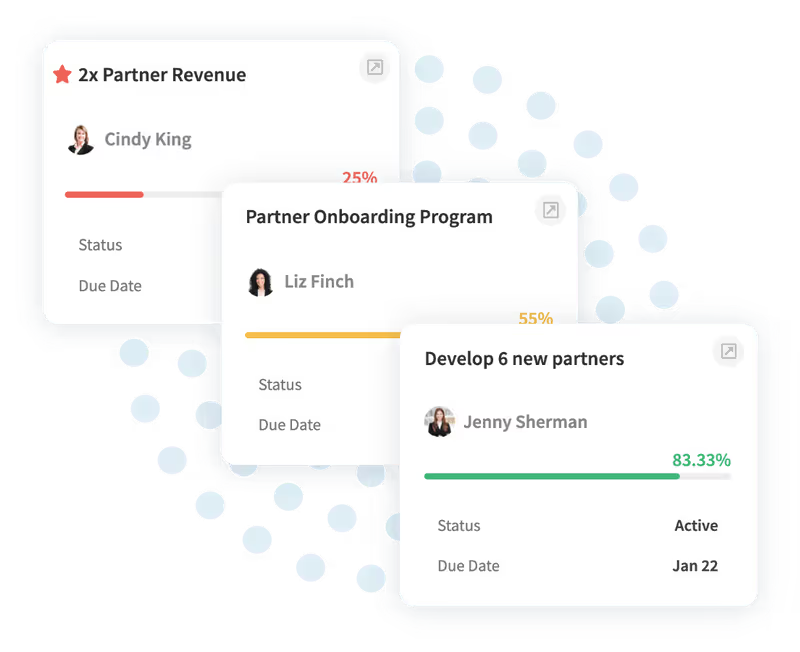What are Cascading Goals & How to Use Them
The idea of using goals as the lifeline between a company's grandest vision and an individual employee's daily actions has been around for decades.
So why do only 14% of employees know their company’s objectives?
It's not like organizations don't bother to set goals — 65% of organizations have an agreed-upon strategy. But, creating a strategy is easy. Executing it is a whole other ball game. Less than 10% of all organizations succeed in executing their strategies.
Delivering solid results over the long-term is what makes a company (and its leaders) great. But the secret to consistent performance, are the people who make the strategy happen at the ground level.
That's where cascading goals can help if you use them right.
What Are Cascading Goals?
Cascading goals are a framework to get everyone in an organization aligned with the big picture organizational goal, and to make sure they know what to do by breaking strategy into clear tasks and deliverables. Goals are seen in a "cascade" with clear objectives. This makes it easier to communicate and document strategy, while eliminating confusion over who owns what, when a goal needs to be accomplished, or even how to achieve a goal.

According to Billy Elliott, Country Manager of the Top Employers Institute in Africa, “Unless organizations take specific steps to cascade goals throughout the organization and align these with employee goals, the best laid plans will come to nothing. To drive true purpose and effectiveness in the everyday lives of employees, the company strategy needs to be filtered down to each level of staff."
Cascading your goals is how you achieve that "filtering down" so that no one in the organization is ever confused about what to do or when to do it.
The Pros and Cons of Cascading Goals
Like all things in life, business and HR, there are two sides of every story. The magic of cascading goals will be quickly lost, if you fail to use them intentionally.
While cascading goals are a great way to break down your company's vision into actionable chunks employees can bite into, they're also inherently hierarchical and can become prone to the kind of bureaucratic workflows and tunnel vision that have upended many an industry dinosaur.
Pros
- Align business objectives with employee goals
- Increase transparency and accountability when shared publicly
- Reduces workflow redundancies, conflicting objectives and unclear responsibilities
Cons
- Prone to blanketing diverse departments under one generic goal
- Can become a time-intensive red tape exercise where the real goal becomes muddled
- Can become rigid and outdated if not actively tracked and followed up
Stuart Hearn, commercial director at HR software company Vaado Software (previously HR director at Sony Music Publishing) sums it up perfectly in an interview for HR Magazine:
"If performance management is taken seriously within the senior team and they lead by example, then this tends to cascade through the organization. In organizations where the process is HR-driven and senior management is not committed to performance management, it tends to be more of a box-ticking exercise."
With cascading goals, any attempt to "set it and forget it" will backfire. Let's take a closer look at how to use cascading goals for good (rather than superfluous HR "box-ticking").
Alternatives to Cascading Goals
There are other goal setting types out there, it just depends on the level of effectiveness your company is seeking.
Tactical goals - Tactical goals are tied to strategy-mind organizational goals, which outline what must be achieved within the organization via tactical goals and objectives. If there's a tactical goal to reduce total costs, the different company sections will set tactical objectives to offset whatever number they need to meet that goal.
Operational goals - Operational goals focus on employees' responsibilities. If X number of sales need to be hit within a quota for a sales team, the sales manager may have an operational objective of increasing sales by whatever percent is marked. One of the problems with this mindset, though, is observing goals and aiming too high at the risk of losing workers.
Superordinate goals - Superordinate goals are goals typically used to resolve conflict. This is a method to relieve tension between groups. The point of this practice is to create camaraderie, trust, and friendship, potent motivators for groups to resolve differences and cooperate. Everyone here must champion that this is a mutually beneficial practice to see the company thrive.
3 Must-Know Tips for Effective Cascading Goals
If you're doing it right, your cascading goal process won't stop after the CEO sets those initial goals.
Here are a few ways to break free of the linear approach and make your cascading goal setting process equally as dynamic as your business (and the people in it).
1. Get Real about Your Goals
Don't overload your performance management process with too many organizational goals — but don't force autonomous departments to adopt one blanket goal, either.
Think about the top 3 things you really want to achieve and be SMART (e.g., Specific, Measurable, Achievable, Realistic and Time-Based) about how you set out to achieve them at every level of your cascading goal process.

2. Check Your Alignment
Alignment is key. Rather than investing all your energy at the front-end (setting up a strategic top-level goal and then walking away), give each department and employee some autonomy in setting the goals that make the most sense for them.
Make sure everyone is completely clear on what tasks are assigned to each goal, then set firm deadlines, performance metrics, and dates and reminders for check-ins.
3. Always Follow Up
Creating a strategic goal may feel like a lot of work for your CEO, but it's nothing compared to the burden your employees will feel if they don't have the tools and support they need to achieve those goals.
Always align goal reviews with performance reviews and make it a point to ask your people if they're getting the resources they need (including training, mentorship, and clear and specific feedback) in order to keep moving toward their goals.



.jpg)

